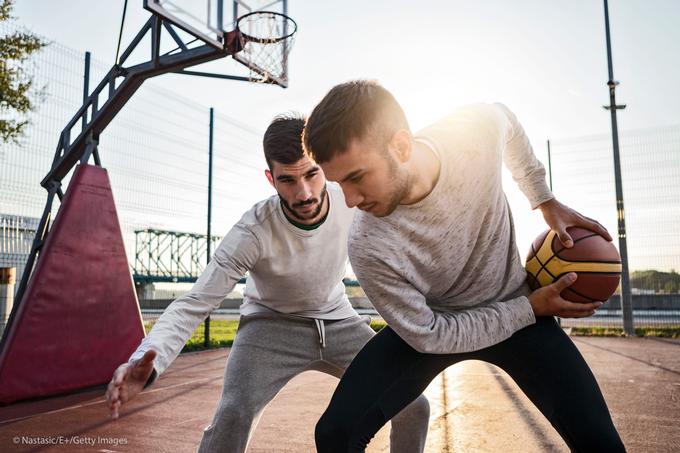
Published 5/4/2018
ROSEMONT, Ill. (May 1, 2018)–Participating in a friendly game of basketball is a fun way to exercise while enjoying your favorite sport. Whether playing recreationally or professionally, this fast-paced sport provides a full body workout helping to build muscle strength and bone density. However, one foul play can lead to painful injuries of the foot, ankle or knee.
According to the Consumer Product Safety Commission (CPSC), in 2016, emergency departments, doctors’ offices and clinics treated
EXPERT ADVICE
“Foot and ankle injuries are the most common injuries in basketball,” said AAOS spokesperson and orthopaedic sports medicine surgeon Matthew Matava, MD. “Non-contact twisting injuries to the knee and ankle while racing for the ball, coming down from a rebound, or defending an opposing player can lead to knee ligament and cartilage tears and sprained ankles. The risk for some of these injuries can be lowered by simply wearing the right shoes designed for basketball. Proper shoes with ankle support and good traction for basketball court surfaces are essential.”
The AAOS recommends the following basketball safety tips:
More Information about the AAOS
With more than 38,000 members, the American Academy of Orthopaedic Surgeons is the world’s largest medical association of musculoskeletal specialists. The AAOS provides educational programs for orthopaedic surgeons and allied health professionals, champions and advances the highest quality musculoskeletal care for patients, and is the authoritative source of information on bone and joint conditions, treatments and related issues.
Visit AAOS, at:
Newsroom.aaos.org for bone and joint health news, stats, facts, images and interview requests.
ANationinMotion.org for inspirational patient stories, and orthopaedic surgeon tips on maintaining bone and joint health, avoiding injuries, treating musculoskeletal conditions and navigating recovery.
Orthoinfo.org for patient information on hundreds of orthopaedic diseases and conditions.
Facebook.org/AAOS1
Twitter.com/AAOS1
Instagram/AAOS_1
According to the Consumer Product Safety Commission (CPSC), in 2016, emergency departments, doctors’ offices and clinics treated
- 60,509 people for basketball-related foot injuries
- 355,130 people for basketball-related ankle injuries
- 186,464 people for basketball-related knee juries
EXPERT ADVICE
“Foot and ankle injuries are the most common injuries in basketball,” said AAOS spokesperson and orthopaedic sports medicine surgeon Matthew Matava, MD. “Non-contact twisting injuries to the knee and ankle while racing for the ball, coming down from a rebound, or defending an opposing player can lead to knee ligament and cartilage tears and sprained ankles. The risk for some of these injuries can be lowered by simply wearing the right shoes designed for basketball. Proper shoes with ankle support and good traction for basketball court surfaces are essential.”
The AAOS recommends the following basketball safety tips:
- Proper Preparation for Play. Maintain physical activity by sticking to a balanced fitness program during the off-season. Always warm up and stretch before beginning play. Research has shown that cold muscles are more prone to injury. Warm up with jumping jacks, stationary cycling or running or walking in place for 3 to 5 minutes, especially cold winter months when basketball is frequently played.
- Focus on Technique. Players at all levels benefit from good coaching to assist with proper technique to improve performance and reduce the risk for injury. Play your assigned position and know where other players are on the court to reduce the chance of collisions. Know the rules of the game and avoid illegal contact that involves holding, blocking, pushing, or charging opponents.
- Ensure Appropriate Equipment. Select basketball shoes that fit snugly, offer support, and have non-skid soles. Most have a high-top ankle support, which may reduce the incidence of ankle sprains. Some players use ankle braces or tape to further stabilize the ankle, especially following a prior sprain. Absorbent cotton socks are imperative to reduce the chance for blisters that are especially common with new shoes. Wear a mouth guard to protect your teeth from inadvertent contact.
- Inspect the Court Before Play.
- Outdoor and indoor courts should be properly maintained and free of rocks, holes, cracks, debris, and water. A surface with adequate traction is imperative to reduce the risk of injury.
- Baskets and boundary lines should not be too close to walls, bleachers, water fountains, or other structures.
- Basket goal posts, as well as the walls behind them, should be padded.
- Players should avoid playing in extreme weather or on dark courts that are not properly lit.
More Information about the AAOS
With more than 38,000 members, the American Academy of Orthopaedic Surgeons is the world’s largest medical association of musculoskeletal specialists. The AAOS provides educational programs for orthopaedic surgeons and allied health professionals, champions and advances the highest quality musculoskeletal care for patients, and is the authoritative source of information on bone and joint conditions, treatments and related issues.
Visit AAOS, at:
Newsroom.aaos.org for bone and joint health news, stats, facts, images and interview requests.
ANationinMotion.org for inspirational patient stories, and orthopaedic surgeon tips on maintaining bone and joint health, avoiding injuries, treating musculoskeletal conditions and navigating recovery.
Orthoinfo.org for patient information on hundreds of orthopaedic diseases and conditions.
Facebook.org/AAOS1
Twitter.com/AAOS1
Instagram/AAOS_1